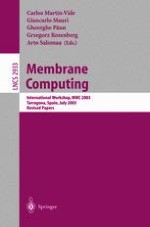2004 | Buch
Membrane Computing
International Workshop, WMC 2003, Tarragona, Spain, July 17-22, 2003. Revised Papers
herausgegeben von: Carlos Martín-Vide, Giancarlo Mauri, Gheorghe Păun, Grzegorz Rozenberg, Arto Salomaa
Verlag: Springer Berlin Heidelberg
Buchreihe : Lecture Notes in Computer Science
Enthalten in: Professional Book Archive
